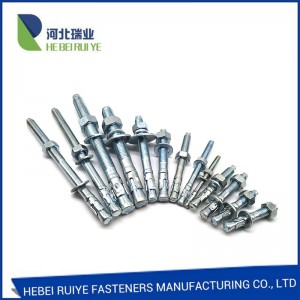Comparison of electro-galvanizing and hot-dip galvanizing
Galvanization
Zinc plating refers to a surface treatment technology that coats a layer of zinc on the surface of metal, alloy or other materials for aesthetics and rust prevention. The main method used is hot-dip galvanizing.
Zinc is soluble in acid and alkali, so it is called amphoteric metal. Zinc hardly changes in dry air. In humid air, a dense basic zinc carbonate film will be formed on the zinc surface. In atmospheres containing sulfur dioxide, hydrogen sulfide, and marine atmospheres, zinc has poor corrosion resistance, especially in high-temperature and high-humidity atmospheres containing organic acids, zinc coatings are easily corroded. The standard electrode potential of zinc is -0.76V. For the steel substrate, the zinc coating is an anodic coating. It is mainly used to prevent corrosion of steel. The quality of its protective performance is closely related to the thickness of the coating. After the zinc coating is passivated, dyed or coated with a light protectant, its protective and decorative properties can be significantly improved.
Elextro-galvanizing
1. Principle
Because zinc is not easy to change in dry air, and in moist air, a very dense zinc carbonate film can be formed on the surface, which can effectively protect the interior from corrosion. And when the plating layer is damaged for some reason to expose a not too large substrate, the zinc and steel substrate form a micro battery, and the fastener substrate becomes the cathode and is protected. It is widely used in automobile transportation and other industries, but what is needed is trivalent chromium passivation layer and zinc-nickel alloy plating seal coating to reduce the harmful and toxic layer of hexavalent chromium passivation.
2. Performance Characteristics
The zinc coating is thick, with fine crystals, uniformity and no porosity, and good corrosion resistance; the zinc coating obtained by electroplating is relatively pure, and it corrodes slowly in the mist of acid, alkali, etc., which can effectively protect the substrate of the fastening sand. The zinc coating is chromium After acid passivation, it will form white, colorful, army green, etc., which is beautiful and decorative. Because the galvanized layer has good ductility, it can be cold punched, rolled, bent and other shapes without damage Plating.
3. Application Scope
Electro-galvanizing involves more and more fields, and the application of fastener products has spread to machinery manufacturing, making galvanized chain link fence, electronics, precision instruments, chemicals, transportation, aerospace, etc. It is of great significance in the national economy.
Hot Dip Galvanized
1. Principle
The hot-dip zinc layer is formed in three steps when zinc is in the liquid state. The surface of the iron base is dissolved by the zinc solution to form a zinc and iron alloy phase layer; the zinc ions in the alloy layer further diffuse to the base to form a zinc and iron mutual dissolving layer; alloy layer The surface is covered with a zinc layer.
2. Performance Characteristics
The thick and dense pure zinc layer covers the surface of the steel fasteners, which can prevent the steel substrate from contacting any corrosive solution and protect the steel fastener substrate from corrosion. In the general atmosphere, a very thin and dense zinc oxide layer is formed on the surface of the zinc layer. It is difficult to dissolve in water, so it can protect the base of steel fasteners. If zinc oxide forms insoluble zinc salts with other components in the atmosphere, the anti-corrosion effect is more ideal; it has a zinc-iron alloy alloy layer, which is densely combined, and exhibits unique corrosion resistance in marine salt spray atmosphere and industrial atmosphere; due to the combination Strong, zinc-iron is mutually soluble, and has strong wear resistance; because zinc has good ductility, its alloy layer is firmly attached to the steel matrix, so hot-dip galvanizing can be cold punched, rolled, wire drawn, bent, etc. The forming process does not damage the coating; after the steel structural parts are hot-dip galvanized, it is equivalent to an annealing treatment, which can effectively improve the mechanical properties of the steel matrix, eliminate the stress during the forming and welding of the steel parts, and is conducive to turning the steel structural parts; The surface of the fasteners after galvanizing is bright and beautiful; the pure zinc layer is the most plastic galvanized layer in hot-dip galvanizing, and its properties are basically close to pure zinc, with good ductility.
3. Application Scope
This plating method is particularly suitable for various strong acids, alkali mists and other strong corrosive environments.

